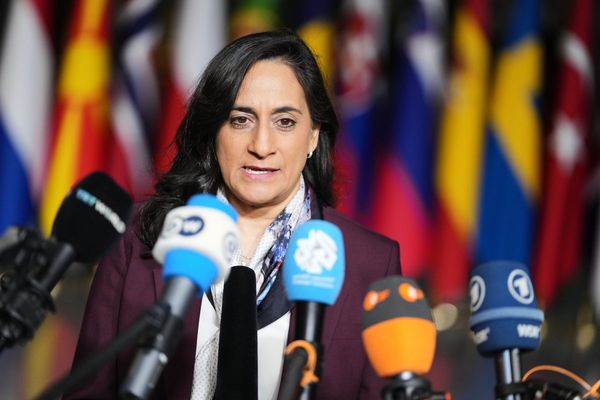/Solar%20Panels%20City%20by%20Fuyu%20Liu%20via%20Shuttershock.jpg)
If President Donald Trump’s “Big Beautiful Bill” passes, it would not be so beautiful for companies in the solar industry. This reality was evident in the meltdown that solar stocks witnessed on news that the Senate version of the bill looks to fully phase out both solar and wind power tax incentives by 2028.
So, where does that leave First Solar (FSLR), whose shares have corrected by nearly 18% already this year? In a pretty good place, if analysts are to be believed.

About First Solar
First Solar specializes in large-scale utility solar projects and integrated photovoltaic (PV) systems. The company designs, manufactures, and sells CdTe thin-film photovoltaic modules and is the only major solar manufacturer headquartered and producing in the U.S. Its market cap currently stands at $15.4 billion, making it one of the largest companies in the industry.
Now, there are some valid reasons for FSLR stock’s decline with the “Big Beautiful Bill” chief among them. With such legislation pending, investors fear that developers may cancel or delay new solar installations, shrinking First Solar’s total addressable market. Consequently, this may hurt project bookings and revenue visibility for First Solar.
However, I reckon First Solar’s correction has been overdone, and projections about its downturn extending further are misplaced. Why? Let’s have a closer look.
First Solar’s Financials Are Not That Worrisome
First Solar has had a tough time in recent quarters as its earnings have missed estimates, with the latest quarter even seeing the company’s earnings witness a yearly decline. However, its net sales did surpass the Street estimates and rose on an annual basis, accompanied by a decrease in short-term debt.
In Q1 2025, First Solar reported net revenues of $844.6 million, up 6.4% from the previous year. However, earnings of $1.95 per share reflected a yearly fall of 11.4%, missing the consensus estimate of $2.50 by a considerable margin. A yearly jump of 18.5% in total operating expenses to $123.2 million resulted in the sharp drop in profits.
First Solar also cut its revenue guidance for 2025 to be between $4.5 billion and $5.5 billion from prior estimates of $5.3 billion and $5.8 billion.
Net cash from operating activities was at a negative $607.9 million compared to the positive figure of $267.7 million in the year-ago period. However, First Solar closed the quarter with a cash balance of $837.6 million, which exceeded the company’s short-term and long-term debt levels of $197.2 million and $327.9 million.
Lastly, management remains confident about the company’s long-term prospects based on its “Made in USA” strategy with CEO Mark Widmar commenting, "Despite the near-term challenges presented by the new tariff regime, we believe that the long-term outlook for solar demand, particularly in our core U.S. market, remains strong, and that First Solar remains well-positioned to serve this demand. This belief is based on the unique profile of First Solar compared to its peers, as America’s largest, and most established solar module manufacturer, and the country’s only fully vertically integrated producer, our significant network of domestic supply chain vendors, and our proprietary CadTel-based semiconductor.”
Shining Light in a Growing Industry
First Solar appears poised to win the battle for solar industry dominance for a few reasons.
First is its unique CdTe thin-film solar technology, which gives the company a distinct advantage by insulating its supply chain from the risks associated with China-dependent crystalline silicon. With roughly 95% of solar modules globally based on crystalline silicon, First Solar stands out as the only large-scale solar manufacturer with international reach using cadmium telluride technology. This allows for a level of energy independence that isn’t achievable through cost savings alone.
Another key strength is its strong domestic manufacturing base. First Solar currently holds the largest solar production footprint within the U.S., and by 2026, it is expected to operate 14 GW of vertically integrated production capacity across the country. This includes the 3.5 GW facility in Alabama, which began operations last year, and a new Louisiana-based 3.5 GW plant that is on track to become commercially operational by year-end. These capacity expansions reflect the company’s ongoing commitment to scaling operations in anticipation of rising electricity demand.
The surge in artificial intelligence-driven infrastructure further plays to First Solar’s strengths. AI data centers are projected to account for nearly half of all new power demand this decade, with solar energy likely to become the primary source fueling the next phase of digital development. First Solar’s product line, especially its utility-scale thin-film modules, is particularly suited to meet the reliability and performance requirements of this growing segment. In fact, the company has secured supply deals with project developers who build facilities for hyperscale customers, effectively placing First Solar at the core of the AI-powered energy transition. Overall, its domestically manufactured modules are now playing a critical role in supporting data centers, chip manufacturing plants, and automated production hubs across the U.S.
Analyst Opinions on FSLR Stock
Analysts remain bullish on First Solar stock, assigning it a rating of “Strong Buy” with a mean target price of $211.81. This denotes upside potential of about 45.5% from current levels. Out of 31 analysts covering the stock, 25 have a “Strong Buy” rating, two have a “Moderate Buy” rating, three have a “Hold” rating, and one has a “Strong Sell” rating.








